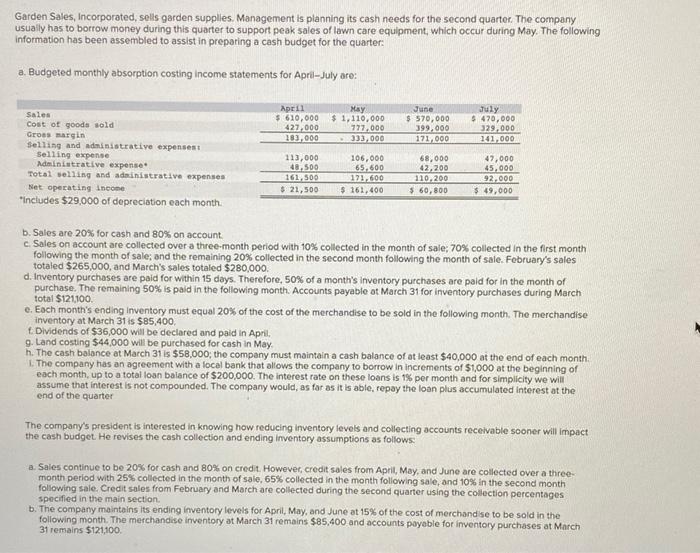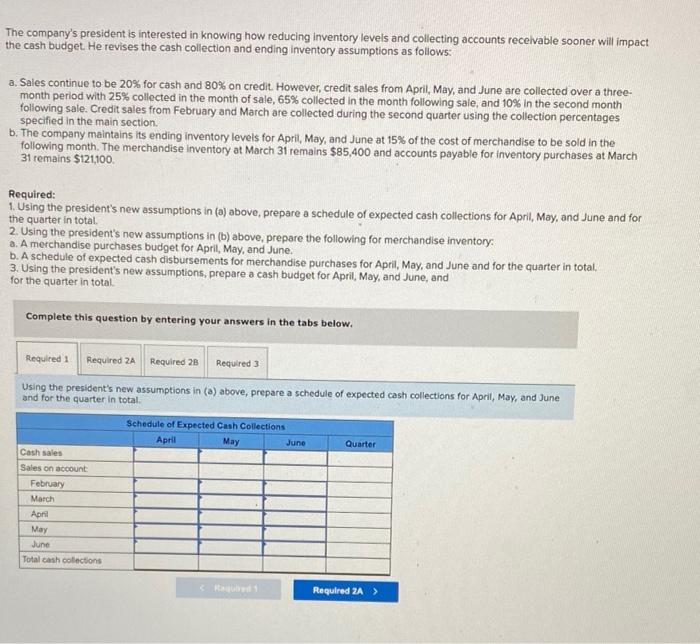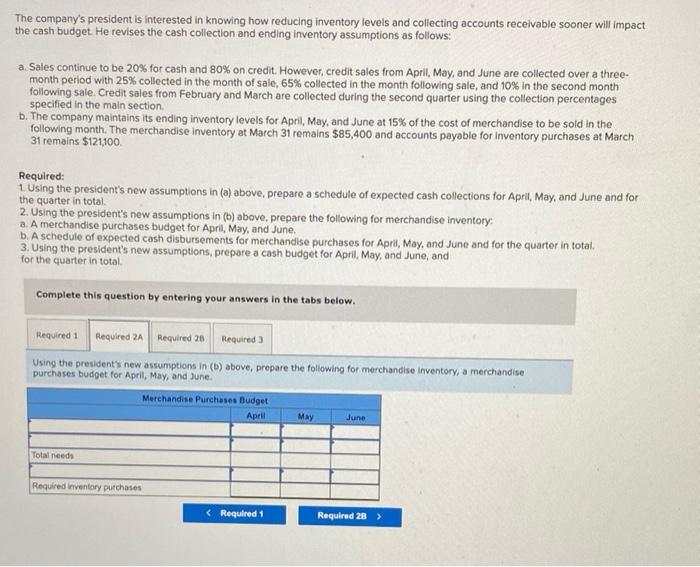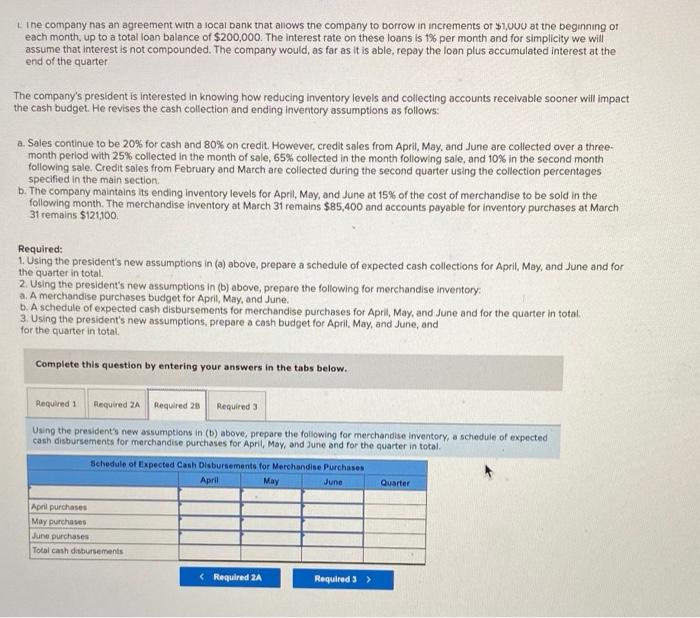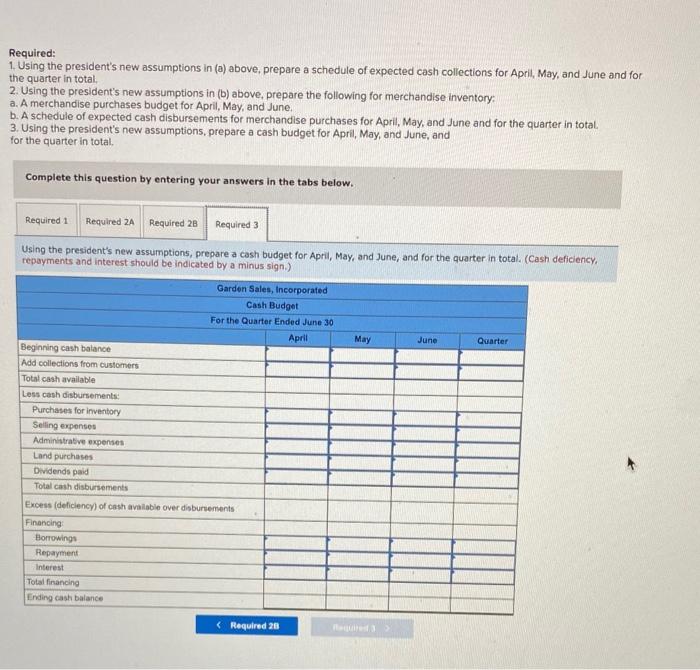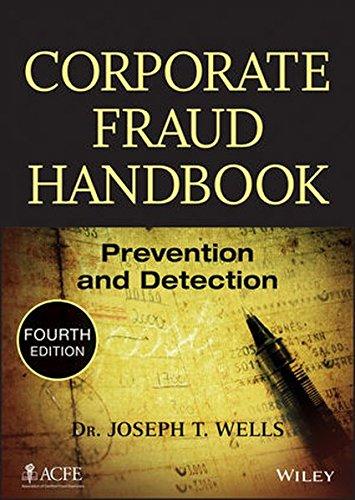Garden Sales, Incorporated, sells garden supplles. Management is planning its cash needs for the second quarter. The company usually has to borrow money during this quarter to support peak sales of lawn care equipment, which occur during May. The following information has been assembled to assist in preparing a cash budget for the quarter: a. Budgeted monthly absorption costing Income statements for April-July are: April $ 610,000 427,000 183,000 May $ 1,110,000 777.000 3,000 June $ 570,000 399,000 171.000 July $ 470,000 329,000 141,000 Sales cost of goods sold Gross margin Selling and administrative expenses Selling expense Administrative expense Total selling and administrative expenses Bet operating income "Includes $29,000 of depreciation each month 113,000 48,500 161,500 $21,500 106,000 65,600 171,600 $ 161,400 68,000 42,200 120.200 560,800 47,000 45,000 92.000 $ 49,000 b. Sales are 20% for cash and 80% on account c Sales on account are collected over a three-month period with 10% collected in the month of sale: 70% collected in the first month following the month of sale; and the remaining 20% collected in the second month following the month of sale. February's sales totaled $265,000, and March's sales totaled $280,000 d. Inventory purchases are paid for within 15 days. Therefore, 50% of a month's inventory purchases are paid for in the month of purchase. The remaining 50% is paid in the following month. Accounts payable at March 31 for inventory purchases during March e. Each month's ending Inventory must equal 20% of the cost of the merchandise to be sold in the following month. The merchandise inventory at March 31 is $85,400, f. Dividends of $36,000 will be declared and paid in April, 9. Land costing $44,000 will be purchased for cash in May h. The cash balance at March 31 is $58,000; the company must maintain a cash balance of at least $40,000 at the end of each month L. The company has an agreement with a local bank that allows the company to borrow in increments of $1,000 at the beginning of each month, up to a total loan balance of $200,000. The interest rate on these loans is 1% per month and for simplicity we will assume that interest is not compounded. The company would, as far as it is able, repay the loon plus accumulated interest at the end of the quarter The company's president is interested in knowing how reducing inventory levels and collecting accounts receivable sooner will impact the cash budget. He revises the cash collection and ending inventory assumptions as follows: a Sales continue to be 20% for cash and 80% on credit. However, credit sales from April, May, and June are collected over a three- month period with 25% collected in the month of sale, 65% collected in the month following sale, and 10% in the second month following sale. Credit sales from February and March are collected during the second quarter using the collection percentages specified in the main section b. The company maintains its ending inventory levels for April, May, and June at 15% of the cost of merchandise to be sold in the following month. The merchandise inventory at March 31 remains $85,400 and accounts payable for inventory purchases at March 31 remains $121,100. The company's president is interested in knowing how reducing inventory levels and collecting accounts receivable sooner will impact the cash budget. He revises the cash collection and ending inventory assumptions as follows: a. Sales continue to be 20% for cash and 80% on credit. However, credit sales from April, May, and June are collected over a three- month period with 25% collected in the month of sale, 65% collected in the month following sale, and 10% in the second month following sale. Credit sales from February and March are collected during the second quarter using the collection percentages specified in the main section. b. The company maintains its ending inventory levels for April, May, and June at 15% of the cost of merchandise to be sold in the following month. The merchandise inventory at March 31 remains $85,400 and accounts payable for inventory purchases at March 31 remains $121,100 Required: 1. Using the president's new assumptions in (a) above, prepare a schedule of expected cash collections for April, May, and June and for the quarter in total 2. Using the president's new assumptions in (b) above, prepare the following for merchandise inventory: a. A merchandise purchases budget for April May, and June. b. A schedule of expected cash disbursements for merchandise purchases for April, May, and June and for the quarter in total 3. Using the president's new assumptions, prepare a cash budget for April, May, and June, and for the quarter in total Complete this question by entering your answers in the tabs below. Required 1 Required 2A Required 28 Required 3 Using the president's new assumptions in () above, prepare a schedule of expected cash collections for April, May, and June and for the quarter in total Schedule of Expected Cash Collections April May June Quarter Cash sales Sales on account February March Apri May June Total cash collections a Required 2A > The company's president is interested in knowing how reducing inventory levels and collecting accounts receivable sooner will impact the cash budget. He revises the cash collection and ending inventory assumptions as follows: a Sales continue to be 20% for cash and 80% on credit. However, credit sales from April, May, and June are collected over a three- month period with 25% collected in the month of sale, 65% collected in the month following sale, and 10% in the second month following sale. Credit sales from February and March are collected during the second quarter using the collection percentages specified in the main section b. The company maintains its ending inventory levels for April, May, and June at 15% of the cost of merchandise to be sold in the following month. The merchandise Inventory at March 31 remains $85,400 and accounts payable for inventory purchases at March 31 remains $121100 Required: 1. Using the president's new assumptions in () above, prepare a schedule of expected cash collections for April, May, and June and for 2. Using the president's new assumptions in (b) above, prepare the following for merchandise inventory: a. A merchandise purchases budget for April, May, and June b. A schedule of expected cash disbursements for merchandise purchases for April, May, and June and for the quarter in total 3. Using the president's new assumptions, prepare a cash budget for April, May, and June, and for the quarter in total Complete this question by entering your answers in the tabs below. Required 1 Required 2A Required 20 Required) Using the president's new assumptions in (s) above, prepare the following for merchandise inventory, a merchandise purchases budget for April, May, and June. Merchandise Purchases Budget April May June Total needs Required inventory purchases L. The company nas an agreement with a local bank that allows the company to borrow in increments of $1,000 at the beginning of each month, up to a total loan balance of $200,000. The interest rate on these loans is 1% per month and for simplicity we will assume that interest is not compounded. The company would, as far as it is able, repay the loan plus accumulated interest at the end of the quarter The company's president is interested in knowing how reducing inventory levels and collecting accounts receivable sooner will impact the cash budget. He revises the cash collection and ending Inventory assumptions as follows: a. Sales continue to be 20% for cash and 80% on credit. However, credit sales from April, May, and June are collected over a three- month period with 25% collected in the month of sale, 65% collected in the month following sale, and 10% in the second month following sale. Credit sales from February and March are collected during the second quarter using the collection percentages specified in the main section b. The company maintains its ending Inventory levels for April, May, and June at 15% of the cost of merchandise to be sold in the following month. The merchandise Inventory at March 31 remains $85,400 and accounts payable for inventory purchases at March 31 remains $121100 Required: 1. Using the president's new assumptions in (a) above, prepare a schedule of expected cash collections for April, May, and June and for 2. Using the president's new assumptions in (b) above, prepare the following for merchandise inventory: a. A merchandise purchases budget for April, May, and June b. A schedule of expected cash disbursements for merchandise purchases for April, May, and June and for the quarter in total. 3. Using the president's new assumptions, prepare a cash budget for April, May, and June, and for the quarter in total Complete this question by entering your answers in the tabs below. Required 1 Required 2A Required 28 Required Using the president's new assumptions in (b) above, prepare the following for merchandise inventory, a schedule of expected cash disbursements for merchandise purchases for April, May, and June and for the quarter in total Schedule of Expected Cash Disbursements for Merchandine Purchases April May June Quarter April purchases May purchases June purchases Total cash disbursements Required: 1. Using the president's new assumptions in (a) above, prepare a schedule of expected cash collections for April, May, and June and for the quarter in total 2. Using the president's new assumptions in (b) above, prepare the following for merchandise inventory: a. A merchandise purchases budget for April, May, and June b. A schedule of expected cash disbursements for merchandise purchases for April, May, and June and for the quarter in total. 3. Using the president's new assumptions, prepare a cash budget for April, May, and June, and for the quarter in total Complete this question by entering your answers in the tabs below. Required 1 Required 2A Required 2B Required 3 Using the president's new assumptions, prepare a cash budget for April, May, and June, and for the quarter in total. (Cash deficiency, repayments and interest should be indicated by a minus sign.) Garden Sales, Incorporated Cash Budget For the Quarter Ended June 30 April May June Quarter Beginning cash balance Add collections from customers Total cash available Less cash disbursements: Purchases for Inventory Selling expenses Administrative expenses Land purchases Dividends paid Total cash disbursements Excess (deficiency) of cash available over disbursements Financing Borrowings Repayment Interest Total financing Ending cash balance
